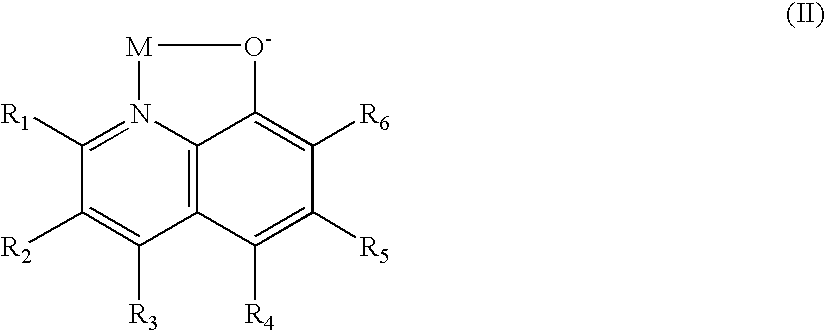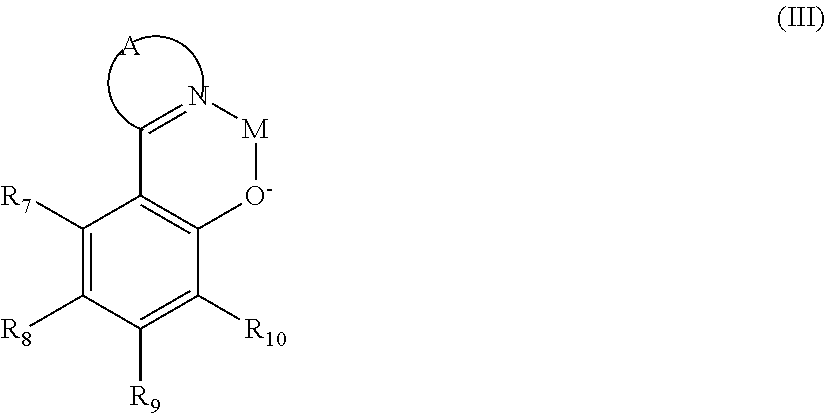OLED device employing alkali metal cluster compounds
a technology of alkali metal clusters and oled devices, which is applied in the field of alkali metal cluster compounds, can solve the problems of unreported clustering of materials, performance limitations that have been a barrier to many desirable applications, and achieve the effects of improving efficiency, reducing drive voltage, and operating stability
- Summary
- Abstract
- Description
- Claims
- Application Information
AI Technical Summary
Benefits of technology
Problems solved by technology
Method used
Image
Examples
experimental examples
[0369]Schematically the synthesis of lithium 2-(1,10-phenanthrolin-2-yl)-phenolate (5), the starting material needed for the preparation of Inv-1, is outlined in Scheme 1.
[0370]
2-Chloro-1,10-Phenanthroline, (1)
[0371]2-Chloro-1,10-phenanthroline was prepared from 1,10-phenanthroline following the procedure of B. E. Halcrow, Wm. O. Kermack; Journal of the Chemical Society (1946), 155-7 and was isolated in satisfactory yield.
2-(2-Methoxyphenyl)-1,10-Phenanthroline Hydrochloride Chloride, (3)
[0372]2-Chloro-1,10-phenanthroline (5.9 g, 27.5 mMole), 2-methoxyphenylboronic acid (2) (5 g, 33 mMole), tetrakis(triphenylphosphine)palladium(0) (1 g, 0.825 mMole), 2M-Na2CO3 (33 mL, 66 mMole) and ethanol (8 mL) were suspended in toluene (70 mL) and heated to 100° C. with good stirring for 24 hours. At the end of this period the reaction was cooled, diluted with ethyl acetate (200 mL) and the aqueous layer run off. The organic layer was washed with water (3×100 mL) and intermittently with brine to ...
example 1
(Route B):—Alternative Synthesis of Inventive Compound, Inv-1 Via Direct Sublimation
[0377]Lithium quinolate, (5) (1.5 g, 9.93 mMole), and lithium 2-(1,10-phenanthrolin-2-yl)-phenolate, (6) (1.4 g, 4.96 mMole) were ground to an intimate mixture in a mortar and pestle. This material mixture was then sublimed at 290° C. / 10−3 mm Hg to give 1.5 g of Inv-1.
example 2
(Route B):—Synthesis of Inventive Compound, Inv-5 Via Direct Sublimation
[0378]Lithium pentafluorophenolate (1 g, 1.32 mMole), and lithium 2-((1,10-phenanthrolin-2-yl)-phenolate, (6) (0.37 g, 0.66 mMole) were ground to an intimate mixture in a mortar and pestle. This material mixture was then sublimed at 235° C. / 10−3 mm Hg to give 0.2 g of Inv-5.
PUM
| Property | Measurement | Unit |
|---|---|---|
| boiling point | aaaaa | aaaaa |
| thick | aaaaa | aaaaa |
| operating voltages | aaaaa | aaaaa |
Abstract
Description
Claims
Application Information
 Login to View More
Login to View More - R&D
- Intellectual Property
- Life Sciences
- Materials
- Tech Scout
- Unparalleled Data Quality
- Higher Quality Content
- 60% Fewer Hallucinations
Browse by: Latest US Patents, China's latest patents, Technical Efficacy Thesaurus, Application Domain, Technology Topic, Popular Technical Reports.
© 2025 PatSnap. All rights reserved.Legal|Privacy policy|Modern Slavery Act Transparency Statement|Sitemap|About US| Contact US: help@patsnap.com



